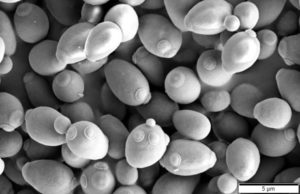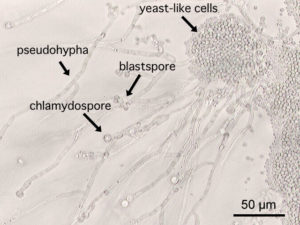Ever wonder why bread rises or how beer gets its alcohol? It’s because of this very important fungus, Saccharomyces cerevisiae, more commonly known as baker’s yeast or brewer’s yeast. I am sure you didn’t realize you were eating and drinking fungus! It’s believed that the Ancient Egyptians discovered Saccharomyces cerevisiae and began using it in bread. It made their bread rise and become soft and fluffy unlike their usual unleavened bread of the time. Beer was also discovered in Egypt and along with bread is one of the most common foods in all parts of the world today.
This S.cerevisiae is the microorganism behind the most common type of fermentation.

Saccharomyces cerevisiae
The origin of this word comes from the Greek-Latin “saccharon” = sugar and “myces” =fungus. Also “cerevisiae” comes from Latin and it means “of beer”.
Baker’s yeast and brewer’s yeast are extremely easy to cultivate, causing them to be commonly used in everyday foods. Saccharomyces cerevisiae is one of the most commonly used yeast used in microbiology, and it was actually the first eukaryote to have its entire genome sequenced.

Nutritional yeast
I wanted to explore a bit today this fascinating fungus because I am likewise fascinated by the importance of this humble yeast in our civilization, in our day-by-day life and in our health. This microscopic fungus has shaped the molecular biology and genetics. It also is now used as a model eukaryotic organism in research activities in hundreds of laboratories worldwide. It wasn’t until a decade ago that the scientific community started to realize how little was known about this yeast’s ecology and natural history, and how this information was vitally important for interpreting its biology.
It was not until the invention of the microscope followed by the pioneering scientific work of Louis Pasteur in the late 1860’s that yeast was identified as a living organism and the agent responsible for alcoholic fermentation and dough leavening.

yeast under microscope
Where can be found? It is everywhere! Literally everywhere! We breathe in an out this fungus on a regular basis. You just need to smash open a fruit of any kind and leave it there for a few hours and you will see the work of this tiny yeast unravelling right under your own eyes.
Yeasts are naturally found floating in air and on just about every surface on Earth, including every opened cheese in your fridge (upon which they will form small cream-colored colonies if left long enough) and on grape skins.
Yeasts are good at making bread, beer, and wine because they are good at harvesting energy from sugar without oxygen, a process called fermentation. In addition to energy, it produces two by-products: carbon dioxide, which puts the lift in leavened bread and the bubbles in beer; and the alcohol called ethanol, which adds interesting but well-known properties to wine and beer, but evaporates in the bread oven. The process is essentially the same for all three foods: fermentation by friendly microbes, a form of controlled spoilage. During fermentation, the yeast also produce many appealing flavors not originally found in the wheat, barley, or grapes, as anyone can attest who’s been intoxicated by the smell of fresh yeast bread, or appreciated how a glass of fine wine differs from a grape.

yeast fermenting the grapes
The fermentation of this yeast is the essential magic involved in turning grape juice into wine. The process has been extensively studied, but there is still so much mystery involved. And how can there be so much diversity in this species of yeast, one of 1,500 types of yeasts, so that different strains of Saccharomyces are capable of generating a different taste profile in the finished wine? It has been estimated that of the 1,000 or more volatile flavor compounds in wine, 40 percent of them are produced by the yeast.
For all their hard work, we often reward the yeast by death in a fiery oven, or by drowning in their own poisonous waste. But without them and their revolutionary food products, it’s safe to say the history of cooking — and history, period — would be a radically different saga.
In May 2013, the Oregon legislature made S. cerevisiae the official state microbe in recognition of the impact craft beer brewing has had on the state economy and the state’s identity as the craft beer-brewing capital of the United State! Way to go Oregon!
